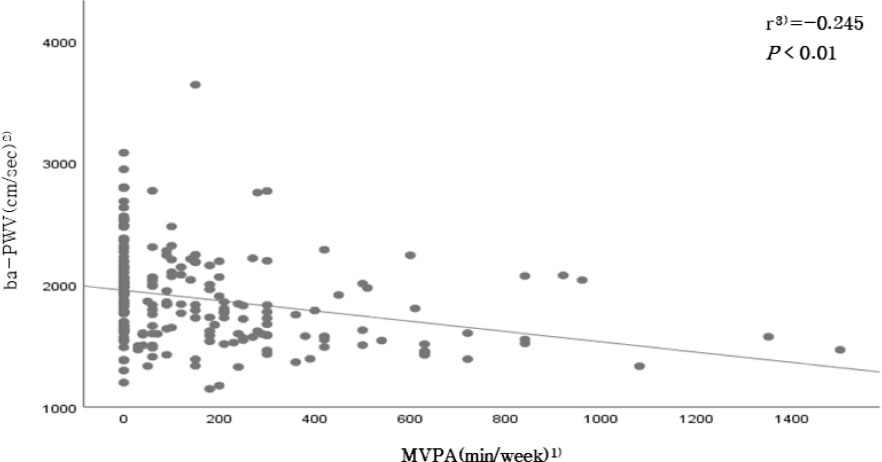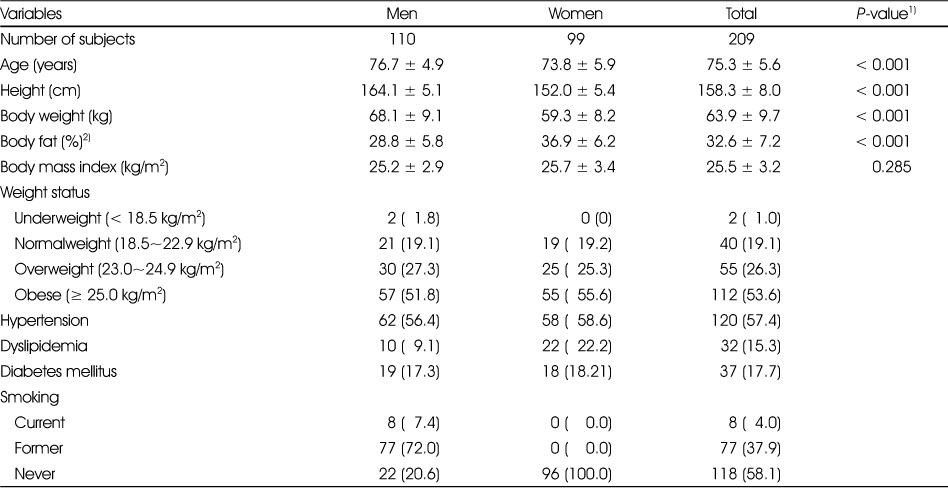Articles
- Page Path
- HOME > Korean J Community Nutr > Volume 25(3); 2020 > Article
- Research Article
- Relationship between Arterial Stiffness and Physical Activity Level Assessed by International Physical Activity Questionnaireshort form (IPAQSF) in the Elderly
- HyunJu Lee, JiYeon Gwak, HaYeon Jun, EunKyung Kim
-
Korean Journal of Community Nutrition 2020;25(3):236-245.
DOI: https://doi.org/10.5720/kjcn.2020.25.3.236
Published online: June 30, 2020

2Graduate Student, Department of Food and Nutrition, GangneungWonju National University, Gangneung, Korea

3Professor, Department of Food and Nutrition, GangneungWonju National University, Gangneung, Korea

-
Corresponding author:
EunKyung Kim,
Email: ekkim@gwnu.ac.kr
- 1,310 Views
- 9 Download
- 3 Crossref
- 0 Scopus
Abstract
Objectives
Cardiovascular disease is a major cause of death in the elderly in Korea. Increased arterial stiffness is linked to risk of cardiovascular disease and mortality. The purpose of this study was to investigate the relationship between arterial stiffness and physical activity in the elderly.
Methods
A total of 209 older adults (110 men and 99 women) participated in this study. Arterial stiffness of subjects such as brachial–ankle pulse wave velocity (baPWV) and ankle brachial pressure index (ABI) was measured using a non-invasive vascular screening device (VP-1000 Plus, Omron, Kyoto, Japan). The interviewed Korean version of the international physical activity questionnaire short form (IPAQ-SF) was used to evaluate subject’s physical activity level and classify subjects as active or inactive group based on the time spent doing moderate to vigorous physical activity (MVPA).
Results
The mean age of total subjects was 75.3 ± 5.6 years. There was no significant difference in sex distribution between the active group (39.7%) and inactive group (60.3%). The baPWV (1,758.1 ± 375.2cm /sec) of the active group was significantly lower than that (1,969.7 ± 372.3 cm/sec) of the inactive group (P < 0.05). There was a significant inverse association between time spent in MVPA and baPWV (r = -0.245, P < 0.01).
Conclusions
This study suggests that physical activity programs for older adults are needed to prevent arteriosclerosis.
Published online Jun 30, 2020.
https://doi.org/10.5720/kjcn.2020.25.3.236
Relationship between Arterial Stiffness and Physical Activity Level Assessed by International Physical Activity Questionnaire-short form (IPAQ-SF) in the Elderly
Abstract
Objectives
Cardiovascular disease is a major cause of death in the elderly in Korea. Increased arterial stiffness is linked to risk of cardiovascular disease and mortality. The purpose of this study was to investigate the relationship between arterial stiffness and physical activity in the elderly.
Methods
A total of 209 older adults (110 men and 99 women) participated in this study. Arterial stiffness of subjects such as brachial–ankle pulse wave velocity (baPWV) and ankle brachial pressure index (ABI) was measured using a non-invasive vascular screening device (VP-1000 Plus, Omron, Kyoto, Japan). The interviewed Korean version of the international physical activity questionnaire short form (IPAQ-SF) was used to evaluate subject's physical activity level and classify subjects as active or inactive group based on the time spent doing moderate to vigorous physical activity (MVPA).
Results
The mean age of total subjects was 75.3 ± 5.6 years. There was no significant difference in sex distribution between the active group (39.7%) and inactive group (60.3%). The baPWV (1,758.1 ± 375.2cm /sec) of the active group was significantly lower than that (1,969.7 ± 372.3 cm/sec) of the inactive group (P < 0.05). There was a significant inverse association between time spent in MVPA and baPWV (r = −0.245, P < 0.01).
Conclusions
This study suggests that physical activity programs for older adults are needed to prevent arteriosclerosis.
Fig. 1
3) Partial correlation coefficient, adjusted for sex, age, BMI, SBP, DBP, medical history and sedentary behavior.
Correlation between MVPA and baPWV
1) Moderate to vigorous physical activity, 2) Brachial–ankle pulse wave velocity.
Fig. 2
Normal group: < mean + 1SD of baPWV; slight sclerosis group: ≥ mean + 1SD and < mean + 2SD; sclerosis group: ≥ mean + 2SD according to age and sex.
baPWV group distribution by physical activity level
Significantly different between active and inactive group by chi-square test.
Table 1
Anthropometric and clinical characteristics of subjects by sex
Table 2
Blood pressure, arterial stiffness indicators and physical activity of subjects by sex
Table 3
Comparison of anthropometric and clinical characteristics between active and inactive groups
Table 4
Comparison of arterial stiffness indicators between active and inactive groups
Acknowledgments
This study was supported by 2018 Academic Research Support Program in Gangneung-Wonju National University (2018100259).
References
-
GBD 2017 Disease and Injury Incidence and Prevalence Collaborators.. Global, regional, and national incidence, prevalence, and years lived with disability for 354 diseases and injuries for 195 countries and territories, 1990?: a systematic analysis for the Global Burden of Disease Study 2017. Lancet 2018;392:1789–1858.
-
-
O'Donnella CJ, Elosuab R. Cardiovascular risk factors. Insights from Framingham heart study. Rev Esp Cardiol 2008;61(3):299–310.
-
-
Lee NB, Im JJ, Park YB, Jeon YJ. Development of a pulse wave velocity measurement system and assessment of the system reproducibility for the diagnosis of arteriosclerosis. J Korean Inst Orient Med Diagn 2005;9(1):112–124.
-
-
Shin JW, Seok SJ, Lee GH, Choi SC, Hyun KY. Correlation between arterial stiffness and physiological parameters. Korean J Health Serv Manag 2013;7(3):71–82.
-
-
Korean Vascular Research Working Group. Clinical angiology. 1st revision. Seoul: Korean Vascular Research Working Group; 2009. pp. 109-124.
-
-
O'Donovan C, Lithander FE, Raftery T, Gormley J, Mahmud A, Hussey J. Inverse relationship between physical activity and arterial stiffness in adults with hypertension. J Phys Act Health 2014;11(2):272–277.
-
-
Jang DG, Shin SK, Park SH. Relationship between Korean undergraduate students' arterial stiffness and their continuous physical activity and sitting scores. Korean J Phys Educ 2013;52(6):477–486.
-
-
Lee RD, Kanf YJ, Hwang MH. The relationship between physical activity level and arterial stiffness in young female adults. Exerc Sci 2019;28(3):232–239.
-
-
Shin HK, Lee SH, Yang JH. Effects of physical activity level on blood pressure response during graded exercise test and pulse wave velocity in the healthy middle-aged women. Korean J Growth Dev 2014;22(2):143–149.
-
-
Lee JW, Kim DS, Cho EK. Interrelationships and differences of brachial-ankle pulse wave velocity (baPWV), body composition and cardiovascular variables between genders who have been exercised or not in elderly. Korean J Clin Lab Sci 2016;48(4):378–387.
-
-
World Health Organization, Regional Office for the Western Pacific. The Asia-Pacific perspective: redefining obesity and its treatment. 1st revision. Australia: World Health Organization, Regional Office for the Western Pacific; 2000. pp. 15-20.
-
-
World Health Organization. Global recommendations on physical activity for health. Geneva: World Health Organization; 2010.
-
-
IPAQ Research Committee. Guidelines for Data Processing and Analysis of the International Physical Activity Questionnaire (IPAQ) – Short and Long Forms. 2005. pp. 1-15.
-
-
Korea National Health and Nutrition Examination Surveys. Korea health statistics 2018 [Internet]. Korea National Health and Nutrition Examination Survey; 2020 [cited 2020 Jan 16].Available from: http://knhanes.cdc.go.kr/.
-
-
Kim SW, Kim KH, Hwang SY, Choi SH, Lee SJ, Choi YC. The relationship between brachial ankle pulse wave velocity and atherosclerotic risk factors. J Korean Soc Vasc Surg 2008;24(1):6–10.
-

 KSCN
KSCN







 Cite
Cite


